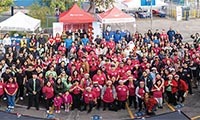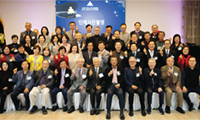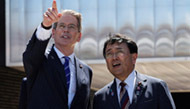Korea Urged to ‘Go Green’ For 2002 World Cup Games
Staff Reporter
SEOUL - An Australian environmentalist March 8 called on Korea to use the World Cup as an opportunity to revive the environment of the Nanjido landfill, located in Sangam-dong, northwestern Seoul, where the sporting event will be staged in May next year.
"The Sydney Olympic Games held in 2000 acted as a big stimulus for environmental improvement in the area, and I think the World Cup games can do the same for cleaning up the Namjido area," said Dr. Kate Hughes, director of ecology programs at the Olympic Coordination Authority of Australia (OCA).
"The World Cup games can also contribute to enhancing public awareness of the environment," she said in an interview with The Korea Times.
Hughes, 50, came to Seoul on March 4 for a six-day visit at the invitation of the Korean Federation for Environmental Movement (KFEM) to exchange ideas on running a green World Cup.
The 2002 competition will be co-hosted by Korea and Japan.
An environmental advocate and campaigner for 20 years, she was in charge of drafting the environmental guidelines for the 2000 Sydney Olympic Games, which were well-known for their environment-friendly management.
"Although the scale is different, there are quite a lot of similarities between Australia and Korea, as they both dealt with landfill issues while preparing for an international event," Hughes said.
Homebush Bay, the site of last yearÕs Olympics, had been degraded for over 100 years, first by land reclamation and later by waste dumping.
"About 160 hectares of the 760-hectare site was used as a garbage dump for 50 years until 1988, which damaged the wetlands and polluted the waterways in the area," she said.
But through a remediation program launched by the Australian government in 1992, the natural environment of the area was revitalized. A total of 137 million Australian dollars were poured into the clean-up project.
"Now, many important birds and plants can again be seen at the site, including the Lathams Snipe, a bird which is also indigenous to Korea," Hughes said.
"The landfills have all been planted with native grasses and trees that suit the soil, and made into parks, walkways and playing fields," she said, adding that Korea could follow AustraliaÕs example in transforming the previous waste site into an environment-friendly one.
"I was flabbergasted after looking at the tremendous size of the garbage hills at the Nanjido site. The landfills in Sydney are quite big, but they look so tiny compared to the ones here," the director said.
Hughes toured the Nanjido site on March 6, which had been used as a waste dump for 15 years until it was closed in 1993 due to its massive pollution of the area.
She said the Korean government should provide people with more detailed information about Nanjido, to raise peopleÕs awareness about the harsh consequences of mass consumption.
"They could start by setting up a simple website, or making brochures explaining the cleanup program and giving them to people who visit the stadium," she stated.
"Community input is also essential in effectively monitoring the clean-up program," she said, adding that a non-government reference group had met every six weeks for nearly three years to keep track of the remediation of the Olympic site.
스마터리빙
more [ 건강]
[ 건강]이제 혈관 건강도 챙기자!
[현대해운]우리 눈에 보이지 않기 때문에 혈관 건강을 챙기는 것은 결코 쉽지 않은데요. 여러분은 혈관 건강을 유지하기 위해 어떤 노력을 하시나요?
 [ 건강]
[ 건강]내 몸이 건강해지는 과일궁합
 [ 라이프]
[ 라이프]벌레야 물럿거라! 천연 해충제 만들기
 [ 건강]
[ 건강]혈압 낮추는데 좋은 식품
[현대해운]혈관 건강은 주로 노화가 진행되면서 지켜야 할 문제라고 인식되어 왔습니다. 최근 생활 패턴과 식생활의 변화로 혈관의 노화 진행이 빨라지고
사람·사람들
more
[송년행사 화보] “이웃과 함께 나누고 지인과 함께하니 행복”
KYCC13일 윌튼 플레이스 초등학교에서 열린 ‘한인타운청소년회관(KYCC) 홀리데이 카니발’이 성황리에 막을 내렸다. 올해는 KYCC 창립 …

[송년행사 화보] “ ‘손에 손잡고’ 한 해 마무리… 건강과 행복 기원”
전주고·북중남가주 전주고·북중 총동창회(회장 백규종)의 2025년 정기총회 및 송년회가 지난 14일 LA 작가의 집에서 성황리에 열렸다. 이날…
[송년행사 화보] “한 해를 마무리하며… 화기애애…
LA 러너스클럽LA 러너스클럽(회장 김두병)은 13일 작가의 집에서 80여명의 회원과 가족이 참석한 가운데 송년회를 마쳤다. 2007년 창립된…
[송년행사 화보] “웃음과 감사 가득 ‘훈훈’… …
한국학교총연합회미주한국학교총연합회(회장 이영숙)가 주최한 제43회 장기 근속교사 포상 및 송년의 밤 행사가 140여명의 교사들이 참석한 가운데…
[송년행사 화보] “친구야 반갑다… 선배님들 모두…
경남중고경남중·고등학교 남가주 동창회(회장 예해덕)는 지난 6일 송년회를 열고 동문 및 가족 60여 명이 참석한 가운데 끈끈한 우정을 확인했다…
많이 본 기사
- 전현무, 차량 링거 결국 입 열었다.. “의사 진료 처방..불법 NO”
- 박수홍 친형, 2심서 징역 3년 6개월 법정구속..형수 오열
- 엔비디아·구글·오픈AI 등 빅테크들, 美 ‘제네시스 미션’ 합류
- 브라운대 총격 용의자 특정…MIT 교수 살해 연관성도 수사
- 음문석, ‘모범택시3’로 보여준 새로운 얼굴
- ‘뇌종양 투병’ 윤석화, 끝내 별세..향년 69세
- ‘주사이모’ 의혹에 입짧은햇님도 활동 중단… “의사라고 믿었다”
- 상속 분야 최고의 크리스마스 선물은 529 플랜일까?
- 서점 직원과의 대화 Do you know where I can find books for toddlers?
- 껍데기는 가라
- 미안해
- 부동산·상속 분야 사전 의료지시서(Medical Directive)의 법적 중요성
- “다카이치, 中갈등 속 내년 봄 美서 트럼프와 회담 추진”
- 12월에
- “1인당 2,000달러 환급금·세금 부담 역대 최저”
- 상설특검, ‘관봉권 폐기’ 확인차 한국은행 수색…첫 강제수사
- 40·50대 은퇴, 자산은 있는데 확신은 없다
- 尹 ‘이종섭 호주도피 사건’ 내달 14일(한국시간) 재판 시작…첫 준비기일
- 중고차 주행거리 조작 ‘주의보’
- 연말이 되면 사라지는 선택들
- ‘주한미군 일방감축 견제’ 부활한 2026년도 美국방수권법 발효
- 크리스마스 연휴 겨울폭풍 남가주 연안 2~4인치 비
- 한국연극배우협회 “윤석화 별세 사실 아냐”…보도자료 정정·사과
- LA산불 여파 ‘심각’ 지역 주민 건강악화
- LA 소파이 스테디엄 8경기 확정
- “건강한 삶 첫걸음은 스트레스 관리”
- 가족이민 전부문 2개월째 전면 동결
- 美·英 10대소년 유가족, 메타 상대 소송… “미성년 성착취 방치”
- 한국 축구, 태백산급 고지대 난관… “손흥민 감아차기도 제동”
- 테슬라, 자율주행 과장광고 적발
- 에어 프레미아 취항, 기대 컸나
- 비트코인, 역대 네번째 연간 하락세
- 거래 더디지만 균형 회복… 리얼터닷컴 내년 주택시장 전망
- [지평선] 판다 없는 일본
- 뉴욕, OKC 잡은 샌안토니오 꺾고 NBA컵 첫 우승
- 가주 신차판매 증가… 전기차 비중은 전국 최고
- “신뢰감 있는 이미지”..김도훈, 광고계 러브콜 쇄도
- 뱅크오브호프, 규모도 1위·봉사활동도 ‘으뜸’
- 챗GPT 앱, 출시 31개월 만에 누적결제액 30억달러
- “금리 대폭인하 신봉자”…트럼프가 곧 낙점할 연준 차기의장 누구
- [로터리] 지멘스가 만드는 미래 동네
- [왈가 왈부] 쿠팡 김범석 “글로벌 CEO라 불출석”… ‘맹탕’ 청문회 불보듯
- [여명] 금붕어를 키우는 오지선다형 수능
- [윌셔에서] 잠시 멈추어 서서
- 김유정, 이번엔 귀신이다.. ‘복수귀’서 박지환→조여정과 호흡
- 브라운대 한인학생, 총격참사 극적 생존
- 11월 소비자물가 2.7%↑ 선방했지만… “자료부족해 구멍숭숭”
- 노스캐롤라이나주 공항서 商用항공기 추락… “7명 사망”
- 북가주 CBMC 송년 감사예배
- 부동산 구입의 과정
1/5지식톡

-
 ☝️해외에서도 가능한 한국어 선생님…
0
☝️해외에서도 가능한 한국어 선생님…
0이 영상 하나면 충분합니다!♥️상담신청문의♥️☝️ 문의 폭주로 '선착순 상담'만 진행합니다.☎️ : 02-6213-9094✨카카오톡ID : @GOODEDU77 (@골뱅이 꼭 붙여주셔야합니다…
-
 테슬라 자동차 시트커버 장착
0
테슬라 자동차 시트커버 장착
0테슬라 시트커버, 사놓고 아직 못 씌우셨죠?장착이 생각보다 쉽지 않습니다.20년 경력 전문가에게 맡기세요 — 깔끔하고 딱 맞게 장착해드립니다!장착비용:앞좌석: $40뒷좌석: $60앞·뒷좌석 …
-
 식당용 부탄가스
0
식당용 부탄가스
0식당용 부탄가스 홀세일 합니다 로스앤젤레스 다운타운 픽업 가능 안녕 하세요?강아지 & 고양이 모든 애완동물 / 반려동물 식품 & 모든 애완동물/반려동물 관련 제품들 전문적으로 홀세일/취급하는 회사 입니다 100% …
-
 ACSL 국제 컴퓨터 과학 대회, …
0
ACSL 국제 컴퓨터 과학 대회, …
0웹사이트 : www.eduspot.co.kr 카카오톡 상담하기 : https://pf.kakao.com/_BEQWxb블로그 : https://blog.naver.com/eduspotmain안녕하세요, 에듀스팟입니다…
-
 바디프렌드 안마의자 창고 리퍼브 세…
0
바디프렌드 안마의자 창고 리퍼브 세…
0거의 새제품급 리퍼브 안마의자 대방출 한다고 합니다!8월 23일(토)…24일(일) 단 이틀!특가 판매가Famille: $500 ~ $1,000Falcon: $1,500 ~ $2,500픽업 & 배송직접 픽업 가능LA…
케이타운 1번가
오피니언
 수잔 최 한미가정상담소 이사장 가정법 전문 변호사
수잔 최 한미가정상담소 이사장 가정법 전문 변호사 [수잔 최 변호사의 LIFE &] AI 시대 편리함에 안주하지 말자
 김도년 성균관대 건축학과 교수 스마트도시·건축학회장
김도년 성균관대 건축학과 교수 스마트도시·건축학회장 [로터리] 지멘스가 만드는 미래 동네

[여명] 금붕어를 키우는 오지선다형 수능
 허경옥 수필가
허경옥 수필가 [윌셔에서] 잠시 멈추어 서서
 양홍주 / 한국일보 논설위원
양홍주 / 한국일보 논설위원[지평선] 판다 없는 일본

[왈가 왈부] 쿠팡 김범석 “글로벌 CEO라 불출석”… ‘맹탕’ 청문회 불보듯
 정숙희 논설위원
정숙희 논설위원칠레에서 영국까지, 27년을 걷다
 마크 A. 시쎈 / 워싱턴포스트 칼럼니스트
마크 A. 시쎈 / 워싱턴포스트 칼럼니스트 [마크 A. 시쎈 칼럼] MAGA와 ‘힘에 바탕한 외교정책’
 김동찬 시민참여센터 대표
김동찬 시민참여센터 대표 [미국은 지금] 위기의 시대, 사회안전망은 최후의 방어선이다
1/3지사별 뉴스

‘브라운대 총기참사’ 뉴욕 한인학생도 총상
▶총상 입은 상황서도 동료학생 의식 잃지않도록 도와 ▶부친도 동문 “우리 가족에게 고통스러운 일”지난 13일 발생한 브라운대학교 총기난사(본보…
뉴욕주 안락사 합법화 초읽기 호쿨, “안전장치 마련되면 서명”

워싱턴 일원 소비 확 줄어들었다
올해 8월 워싱턴DC에 범죄와의 전쟁을 명분으로 주방위군이 본격적으로 배치된 가운데, 이 시기 이후부터 버지니아와 메릴랜드, DC 등 워싱턴 …
“북VA 주택시장 가격 급등 없다”

베이지역 스포츠팀, SF 한인회에 후원금
샌프란시스코 베이지역 한인회(회장 김한일)는 한인 메이저리거 이정후 선수의 소속팀인 샌프란시스코 자이언츠(San Francisco Giants…
불자커뮤니티 20일 청소년발표회및 송년회

오늘 하루 이 창 열지 않음 닫기 



















































.png)


댓글 안에 당신의 성숙함도 담아 주세요.
'오늘의 한마디'는 기사에 대하여 자신의 생각을 말하고 남의 생각을 들으며 서로 다양한 의견을 나누는 공간입니다. 그러나 간혹 불건전한 내용을 올리시는 분들이 계셔서 건전한 인터넷문화 정착을 위해 아래와 같은 운영원칙을 적용합니다.
자체 모니터링을 통해 아래에 해당하는 내용이 포함된 댓글이 발견되면 예고없이 삭제 조치를 하겠습니다.
불건전한 댓글을 올리거나, 이름에 비속어 및 상대방의 불쾌감을 주는 단어를 사용, 유명인 또는 특정 일반인을 사칭하는 경우 이용에 대한 차단 제재를 받을 수 있습니다. 차단될 경우, 일주일간 댓글을 달수 없게 됩니다.
명예훼손, 개인정보 유출, 욕설 등 법률에 위반되는 댓글은 관계 법령에 의거 민형사상 처벌을 받을 수 있으니 이용에 주의를 부탁드립니다.
Close
x